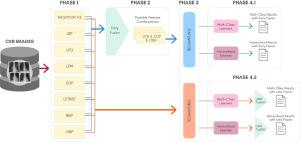Computer Methods and Programs in Biomedicine ( IF 4.9 ) Pub Date : 2020-05-08 , DOI: 10.1016/j.cmpb.2020.105532 Rodolfo M Pereira 1 , Diego Bertolini 2 , Lucas O Teixeira 3 , Carlos N Silla 4 , Yandre M G Costa 3

|
Background and Objective:The COVID-19 can cause severe pneumonia and is estimated to have a high impact on the healthcare system. Early diagnosis is crucial for correct treatment in order to possibly reduce the stress in the healthcare system. The standard image diagnosis tests for pneumonia are chest X-ray (CXR) and computed tomography (CT) scan. Although CT scan is the gold standard, CXR are still useful because it is cheaper, faster and more widespread. This study aims to identify pneumonia caused by COVID-19 from other types and also healthy lungs using only CXR images.
Methods:In order to achieve the objectives, we have proposed a classification schema considering the following perspectives: i) a multi-class classification; ii) hierarchical classification, since pneumonia can be structured as a hierarchy. Given the natural data imbalance in this domain, we also proposed the use of resampling algorithms in the schema in order to re-balance the classes distribution. We observed that, texture is one of the main visual attributes of CXR images, our classification schema extract features using some well-known texture descriptors and also using a pre-trained CNN model. We also explored early and late fusion techniques in the schema in order to leverage the strength of multiple texture descriptors and base classifiers at once.
To evaluate the approach, we composed a database, named RYDLS-20, containing CXR images of pneumonia caused by different pathogens as well as CXR images of healthy lungs. The classes distribution follows a real-world scenario in which some pathogens are more common than others.
Results:The proposed approach tested in RYDLS-20 achieved a macro-avg F1-Score of 0.65 using a multi-class approach and a F1-Score of 0.89 for the COVID-19 identification in the hierarchical classification scenario.
Conclusions:As far as we know, the top identification rate obtained in this paper is the best nominal rate obtained for COVID-19 identification in an unbalanced environment with more than three classes. We must also highlight the novel proposed hierarchical classification approach for this task, which considers the types of pneumonia caused by the different pathogens and lead us to the best COVID-19 recognition rate obtained here.
中文翻译:

在平面和分层分类场景中胸部 X 射线图像中的 COVID-19 识别。
背景和目的: COVID-19 可引起严重肺炎,估计会对医疗保健系统产生重大影响。早期诊断对于正确治疗至关重要,从而可能减轻医疗保健系统的压力。肺炎的标准影像诊断测试是胸部 X 光检查 (CXR) 和计算机断层扫描 (CT) 扫描。尽管 CT 扫描是黄金标准,但 CXR 仍然有用,因为它更便宜、更快且更广泛。本研究旨在仅使用 CXR 图像来识别由 COVID-19 引起的肺炎与其他类型以及健康肺部的肺炎。
方法:为了实现目标,我们考虑以下角度提出了分类模式:i)多类分类;ii) 分层分类,因为肺炎可以构建为分层结构。考虑到该领域的自然数据不平衡,我们还建议在模式中使用重采样算法,以重新平衡类分布。我们观察到,纹理是 CXR 图像的主要视觉属性之一,我们的分类模式使用一些众所周知的纹理描述符以及预训练的 CNN 模型来提取特征。我们还探索了模式中的早期和晚期融合技术,以便同时利用多个纹理描述符和基分类器的优势。
为了评估该方法,我们构建了一个名为 RYDLS-20 的数据库,其中包含不同病原体引起的肺炎的 CXR 图像以及健康肺部的 CXR 图像。类别分布遵循现实世界场景,其中某些病原体比其他病原体更常见。
结果:在 RYDLS-20 中测试的所提出的方法使用多类方法实现了 0.65 的宏观平均 F1 得分,在分层分类场景中识别 COVID-19 的 F1 得分为 0.89。
结论:据我们所知,本文获得的最高识别率是在三类以上的不平衡环境下对COVID-19识别获得的最佳名义率。我们还必须强调针对此任务提出的新颖的分层分类方法,该方法考虑了不同病原体引起的肺炎类型,并引导我们获得此处获得的最佳 COVID-19 识别率。











































 京公网安备 11010802027423号
京公网安备 11010802027423号